Chopped: BLW Edition Part 2
- How to safely prepare 5 foods for baby-led weaning including APPLES, BUTTERNUT SQUASH, TEFF, PORK & SHELLFISH
- Tips on what to DO and what NOT TO DO when it comes to preparing these 5 foods for baby-led weaning

LISTEN TO THIS EPISODE
Episode Description
Your baby is a self-feeding machine just WAITING to happen!! In this episode I’m sharing 5 more foods that you can safely offer your baby for baby-led weaning. We’re going through the DOs and DON’Ts of feeding babies APPLES, BUTTERNUT SQUASH, TEFF, PORK and SHELLFISH (...it’s 1 of the Big 8 allergenic foods - and a LOT easier to feed your baby than you might think!)
Other Episodes Related to this Topic
- Episode 59 - CHOPPED: BLW EDITION PART 1
- Episode 11 - HOW TO INTRODUCE ALLERGENIC FOODS TO YOUR BABY
- Episode 41 - SHELLFISH: HOW TO INTRODUCE YOUR BABY TO THIS POTENTIALLY ALLERGENIC FOOD
Links from this Episode
- Bob’s Red Mill Teff Burgers recipe mentioned in this episode, recipe is here
- Baby-Led Weaning with Katie Ferraro program with the 100 First Foods™ Daily Meal Plan, join here: https://babyledweaning.co/program
- Baby-Led Weaning for Beginners free online workshop with 100 First Foods™ list to all attendees, register here: https://babyledweaning.co/baby-led-weaning-for-beginners

Latest Episodes
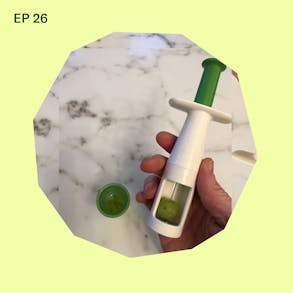
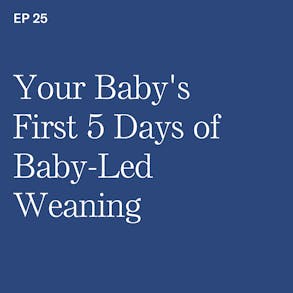
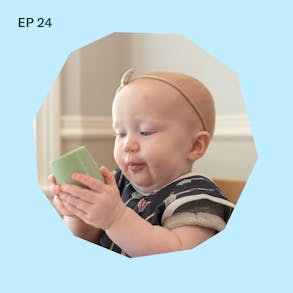
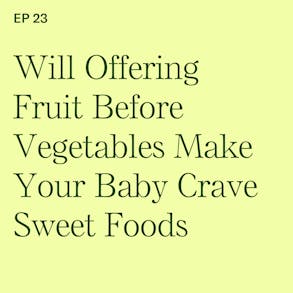
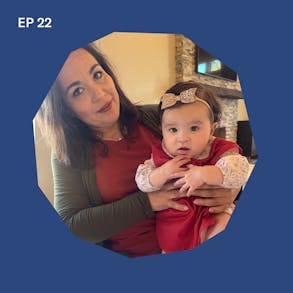
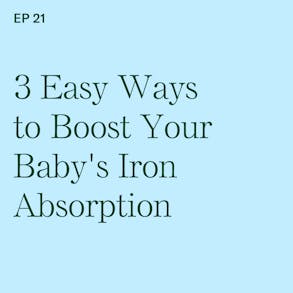
Katie Ferraro (0s):
And babies can eat so many more foods than we give them credit for. Right? That's why my whole 100 First Foods approach is about introducing five new foods for a week for your baby, a new fruit and vegetable, a new starch, a protein, and then one of the allergenic foods today I'm going to walk you through five of those foods. Hey, there I'm Katie Ferraro, registered dietitian, college nutrition professor and mom of seven specializing in baby-led weaning. Here on the Baby-Led Weaning Made Easy Podcast I help you strip out all of the noise and nonsense about feeding, leaving you with the competence and knowledge you need to give your baby a safe start to solid foods using baby-led weaning.
Katie Ferraro (42s):
Hey guys, welcome back to another episode of the Baby-Led Weaning Made Easy Podcast. We are doing chopped today. You guys gave me the idea of doing a chop style episode, a while back on episode number 59, we did chopped BLW edition part one. So what I've written in review on apple podcasts. That's where I get all of my episode ideas from, Hey, you should do chopped. I did it, but I only got through five foods. So, I pick it five extra foods from the list of foods you guys sent me for today's episode. And the way I picked it is I'm going to highlight. This is kind of the same outline than I do in my five step feeding framework, which is for my 100 First Foods program. I do five new foods a week, a new fruit, a new vegetable, a new crane, or starch food, a new protein, and then a new challenge food.
Katie Ferraro (1m 26s):
So the challenge food is always one of the allergenic foods or trickier texture, more complex flavor profile. So, from the whole list of foods, I got, I picked five foods, a fruit. So we're going to do apple today. A vegetable, I'm going to show you how to make butternut squash safely. Teff is going to be the starch because you always got to get a kind of wacky, whole grain in there for your baby to learn how to eat. We're going to do pork is the protein that I'm talking about, shellfish as the allergenic food to introduce. So if you guys are interested in learning about 95 other foods, that you can safely introduce your baby to my digital program, the 100 First Foods field guide that I co-teach with Dawn Winkelmann, who's a speech language pathologist, and she specializes in pediatric swallowing and baby-led weaning.
Katie Ferraro (2m 6s):
We teach this program together 100 First Foods, field guide is open for enrollment right now. It's only open until October 18th of 2020 though. So go to 101st foods.com to check it out. If you're listening to this before that date would love to have you in our small group to help you push your baby's palette to 100 First Foods, Dawn and I do a live Q & A every single week inside of our group during the eight weeks of the program. So, if you have any questions that you want to ask to two different baby-led weaning experts, we are there for you inside of this program, and we're showing you how to safely choose. So, select prepare and offer your baby 100 different baby-led weaning foods with the focus on safety.
Katie Ferraro (2m 47s):
So let's go ahead and get started. We're going to do chopped BLW edition part two. As I like to do with every mini training episode, I want to start out with the baby-led weaning tip of the day. And I mentioned, we're going to be doing apples today. Tip of the day, do not feed your baby raw apples. Raw apples are one of the most frequently cited foods that are choking hazards for babies and even for toddlers as well. So, if you look at the baby-led weaning research, if you look at pediatric emergency department admission data for non-fatal choking in children and infants, you will see apples listed very frequently. So you guys know not to feed your babies, hot dogs and coin shapes. And obviously don't give them hard candy, but apples are an area where parents think, oh, apples are healthy.
Katie Ferraro (3m 29s):
I'll feed them to my baby. Not so. Hang tight in today's episode, I'm going to explain to you how you can make apple safe for baby-led weaning. But please know we don't do that by serving babies raw apples. Now, before I jump into the five foods for the chopped edition, I want to remind you that most babies who start solid foods, if they don't do baby-led weaning, let's say they're doing traditional spoonfeeding, where the parents are driving the spoon with a couple of different purees. Those babies by the time they reach the age of one, they generally only have about 10 or 15 foods under their belt. And that's okay, but your baby can certainly eat significantly more foods than that. And the reasons why I created the whole 100 First Foods program is because we know that babies who are exposed to the greatest variety of foods and flavors and tastes and textures early and often, those are the babies who are more likely to be independent eaters and less likely to be picky eaters.
Katie Ferraro (4m 22s):
Those of you with older children know that the truth is that all babies will develop some degree of picky eating. It generally starts in the second year of life, but here's the deal. If your baby has 100 Foods under his or her belt, by the time he turns one and you lose 10 or 15 of those foods to picky eating in that second year of life, no big deal, right? Your baby still has 85 or 90 foods that he or she will eat. You're cool. For the babies who only have 10 or 15 foods under their belt by the time they turn one, if they lose those 10 or 15 foods to picky eating in the second year of life, that becomes a very, very challenging child to feed. So,it's the underlying rationale for the whole 100 First Foods program is to give your baby the opportunity to learn how to eat a wide variety of foods and flavors and tastes and textures.
Katie Ferraro (5m 9s):
It helps them develop mentally. It helps them from a nutrition and growth standpoint. It helps you because you're getting to a point where your baby can start eating modified versions of the same foods. The rest of the family eats. Again. There's so many benefits to this whole 100 First Foods approach. And if you want to check it out, come join the program at 100firstfoods.com. I'd love to work with you and your baby or babies to help you guys push your baby's palate past those simple starter foods. So, let's go ahead and get started with food. Number one for chop today, we are talking about apples. All right, what do you want to do for apples? You do want to core the apple. You do want to peel the apple the way I like to do apples for baby-led weaning is I make soft baked cinnamon apples or poached cinnamon apples.
Katie Ferraro (5m 53s):
I basically core the apple peel it, cut it into slices, put it in a Dutch oven or a pan on top of the oven or the stove rather put a little bit of water in there, cover it with a lid. You can add cinnamon before or after it doesn't really matter. And then I just simmer it lightly for about 10 minutes until the apples are fork tender. We don't want any crispy foods for babies. Now, if you keep cooking that apple, then you make apple sauce, which is wonderful. You can also serve your baby applesauce. You can do baby-led weaning with the pureed food, like an unsweetened applesauce. If you preload the spoon for your baby. So if you're doing applesauce, you put the applesauce on the spoon, hand the baby spoon to your baby, handle side first.
Katie Ferraro (6m 34s):
You may have to help guide the baby spoon to mouth at first, but your baby will pick up the hang of feeding themselves pretty quickly, but you can also do those soft cinnamon cooked apples. You can add nutmeg. You can add cinnamon. You can add lots of different flavors, but the key is you want to make sure they're soft and they're so easy to do on the stove top. So, that's one thing you do want to do. What do you not want to do with apples? Okay. My goal when teaching baby-led weaning, especially if you're doing a wide variety of foods, like 100 different foods is to make sure you're offering those foods safely. So, we don't want to offer babies, sweetened applesauce, ok? No added sugars for babies aged two and under. And if you go to the store and you look at applesauce, if you're not prone or inclined to be reading your labels, it can be a little bit of confusing.
Katie Ferraro (7m 15s):
I remember one time my brother-in-law went to the grocery store and he texted me like, do you need anything? And he has six kids, five, seven years, six. And so I'm like, yeah, you're going to the store. Like, heck you up. Can you get me some unsweetened applesauce? He texted me 20 minutes later. He's like, I have been standing in the applesauce aisle. There's no such thing as unsweetened applesauce. I don't know you made it up. I was like, oh, it's not actually called unsweetened applesauce at the grocery store. So,if you're not going to like make your own applesauce and you're going to buy it, which is fine. It's just the absence of sugar in the ingredient list that makes an applesauce unsweetened. So, if you look at the packages, this sometimes even within the same brand, they'll look like identical. You have to flip it over, read the ingredient list. O,ne will just say apples and ascorbic acid, which ascorbic acid is just vitamin C.
Katie Ferraro (7m 56s):
You know, if you cut apples and you expose them to oxygen after a while they turn brown. But if you use vitamin C, which is an antioxidant, so it prevents that oxidative Browning. That's why in commercial food preparation, they'll add vitamin C to apple slices. So they don't don't turn brown. They add it to apple sauce as well. So it's like, there's something called ascorbic acid in here. I don't think babies should have that. No, it's fine for babies to have. It's just vitamin C. What you don't want is Apple's sugar and ascorbic acid. So, it's the absence of sugar in the ingredient list that you're looking for. There's some naturally occurring sugar, of course, in apples from fructose, which is fruit, sugar. And that's fine for babies to have, just make sure that the applesauce that you're buying doesn't have added sugar, right? If you're interested in the exact recipe for the cinnamon spiced apples I just mentioned, I have an ebook called the quick start guide to baby-led weaning.
Katie Ferraro (8m 43s):
It's got the cinnamon spiced apples, plus a few of my other favorite combination food recipes. So, once you get past those simple starter foods, when you start combining textures, the Quickstart guide to baby-led weaning has that. And I'll go ahead and link to that ebook. It's a 16 page e-book jam packed with everything you need to get a safe start to solid foods. That'll be on the show notes for this episode, which is at blwpodcasts.com/65. So, the first food for chopped today is apples. The second one, we do a new fruit each week. We just did that. It's apples. The next one, we do a new vegetable each week on day two Tuesday. I like to introduce babies to a new vegetable butternut squash is the one. I got a lot of questions from parents about. So, let's talk about what you do do for butternut squash and what you don't do.
Katie Ferraro (9m 24s):
Okay. Now, disclaimer, butternut squash. I am not a big fan of convenience foods. So, like buying fruits and vegetables that are already prepped, sometimes they cost two, three times as much to do the work that I could have just done in my kitchen. The exception is butternut squash. I am a sucker for butternut squash that has already been peeled and cut for me in those convenient packages in the produce section. So, you can definitely take your own whole butternut squash if you want to. I think if you can find spears of cut butternut squash, great. One thing you want way to stay away from the little tiny cubes of pre-cut butternut squash, especially early on, if your baby is six or seven months of age and doesn't have his or her pincer grasp yet, they're not going to be able to pick up really tiny cubed pieces of a vegetable if it's a cooked vegetable.
Katie Ferraro (10m 11s):
So, we don't want the baby to like get it in their fat little baby hand and then not be able to get it into their mouth. That's what happens before they have their pincer grass. That's why we offer longer strips of soft cooked foods for baby-led weaning that are about the size of your adult pinky finger. So, let's say you are super mom and you've decided to do your own butternut squash. You buy the butternut squash, or you pick it out of your garden if that's you, which if it is, you're amazing. Cut it in half. I personally always struggle cutting, right how good my knives are. A bitter butternut squash is sometimes really hard to cut. So, I kind of choose the smaller ones, cut it in half, scoop the seeds out, put the speed seeds to the side. We're going to talk about them in a second. Either way you can put the butternut squash, the two pieces, either whole side up or whole side down.
Katie Ferraro (10m 54s):
It doesn't really matter. But what I always do is lather the flesh side. So, the cut side of the butternut squash with a lot of oil ok, so you preheat your oven, let's say three 75 or 400 degrees. You can do it lower if you want, but it takes longer. So, I always go so higher and faster because for babies, they don't really know. And I think usually short odd time, but you get your butternut squash ready to go in the oven, lather it with a lot of oil. What kind of oil? I like to choose oils that are mostly unsaturated fats. So I love olive oil. I do a lot of avocado oil for baby-led weaning. Avocado oil has a really high smoke point, meaning that when you're frying like fritters or patties, to make it into a size that the baby can handle.
Katie Ferraro (11m 37s):
The oil, rather, it's not going to burn. You're not going to get that acrid smell. Avocado oil has one of the highest smoke points of oils. Peanut oil is another good one, but for avocado oil, I use that a lot for baby-led weaning because again, it's mostly unsaturated fat, which are the good fats. And then also it has a really mild pleasing flavor, but a super high smoke point. The brand that I use is one called Primal Kitchen. There's two sizes of avocado oil on Primal Kitchen. If you go to, I think it's primalkitchen.com, buy them online. You can use the code Ferraro 10 for 10% off. If you need to order yourself a lot of avocado oil, but use a lot of fat when you're cooking, especially vegetables for babies, because fat provides extra calories, which your baby's slowly getting to the point where they're going to be getting more nutrition from the foods and less from their milk.
Katie Ferraro (12m 19s):
But it also provides a lot of that mouth feel, which is pleasurable to us as humans when we're eating high-fat foods, but also lubricates and makes things nice and moist. I think it enhances the flavor of roasted vegetables as well. So, you've got your butternut squash cut in half. You've lathered it with a bunch of oil, pop it in the oven, cook it until it's fork tender. So, you, again, you don't want any crunchy or crispy parts of foods that we serve to baby. You can peel the butternut squash before or after you roast it. I personally find it such a pain to peel a raw butternut squash. So I'll wait till it's cooked, then let it cool slightly. And then you can even just peel the skin off with your finger. I sometimes end up using a knife again. If you buy the pre-packaged butternut squash, I know Trader Joe's a lot of you guys shop there.
Katie Ferraro (13m 2s):
They do have butternut squash cut in like almost looks like crinkle-cut fries. That's a great size for babies. If you think about the size of like a big French fry or an adult's pinky finger, that's wonderful for baby-led weaning. So, that's how you do do butternut squash offered to your baby. They'll smash it up, squish it up if you're not comfortable doing the soft, solid strips of food, yet you can always puree or mash the really soft cooked butternut squash with some breast milk or some formula and put it on that preloaded spoon, offer it to the baby. If the whole preloaded spoon thing is new to you. The last episode that I did had all about how to preload a baby-led weaning spoon, Dawn Winkleman, who I co-teach, the 100 First Foods program with.
Katie Ferraro (13m 44s):
She came on, she actually designed the tiny spoon for ezpz. She's walking you Step-by-step how to do the preloaded spoon technique for baby-led weaning. If you're offering your baby purees, that's the previous episode. So, If you go to blwpodcast.com/64, you can learn more about that. And again, Dawn and I co-teach the 100 First Food approach. The digital program that we have together, that's now open for enrollment up until October 18th of 2020. If you go to 100firstfoods.com, you can learn more about that. So, now you've got one new fruit, that's apple, one new vegetable it's butternut squash. Oh, I wanted to add what you avoid for butternut squash. We don't feed the seeds to the baby Okay? you can roast in clean and dry and roast the seeds for yourself and salt them or add cumin or chili powder, but we don't give crunchy seeds to babies early on.
Katie Ferraro (14m 33s):
Some parents will then grind up the pumpkin seeds and add a bunch of oil and kind of make like your own seed paste. And that's fine to do again, provided that there are no intact, crunchy seed parts. That's not an appropriate texture for an early eater. Now, a question I get a lot about squash is if you introduce your baby to one squash, is it like one food? Or if you do butternut squash, is that one food? And then you do acorn squash. Is that another food? So, if you do my 100 First Foods program, you'll note there's butternut squash is listed as one food. It's actually day seven. Chayote squash for example is day 42. That's a totally different flavor and texture, even though it's technically a squash. So, I do have two different squashes in the program, but you could sub acorn for butter nut.
Katie Ferraro (15m 13s):
There's a lot of different squashes depending upon what part of the world you're in. It's one of the beauties of the 100 First Foods program is that the foods are flexible. We start with 20 different vegetables, but I show you how you can swap similar foods if you're not able to get them. So, if you're on Instagram, you can get kind of a little bit of an insight as to what the program looks like. If you go to day seven for me on my 100 First Foods program, my Instagram is @babyledweanteam. If you check that highlights up top, I have little snippets of how you can safely food feed your baby butternut squash. So, you can see some of those things I just talked about in-person and see babies eating it. But if you scroll the day 42, I did chayote squash there and you can see about how that's a little bit of a different food that you would feed your baby.
Katie Ferraro (15m 55s):
And I wait a little bit longer to do a food like chayote compared to butternut squash. And again, that's on Instagram @babyledweanteam. Day seven is butternut squash, day 42 is chayote squash. I'll link to everything cause I'm kind of covering a lot of grounded today's episode. I'll put it all in the show notes for this episode at blwpodcast.com/65. And you can link out to these different foods if you want to check them out. So, let's move on to food number three of chopped, we're talking about teff. Teff if you've never heard of it, it's a whole grain. On the first day of the week, I do a new fruit. The second day we knew a new vegetable. The third day we do a new starchy food. Okay? Starches carbohydrate foods are incredibly important for babies. They serve as the primary source of your babies, energy or calories, but we don't want to get stuck on refined white grains like pasta and rice, and other white bread products.
Katie Ferraro (16m 45s):
So, the 100 First Foods program has a list, 20 different starchy foods, many of which are whole grains. And one of which is teff. Now I'm highlighting teff today because someone who's actually in the program was like, I need more info about teff. I'd never even heard of it. So, if you've ever had Ethiopian food, teff is well-known as the base of injera bread. So, it's the spongy Ethiopian flat bread. Teff is a gluten-free whole grain. It's native to the horn of Africa. It's not so prevalent in Western food culture, but very well known in Africa. It's also called the traditional grain of Ethiopia. The way I do teff for babies is I make teff burgers. So, I get a lot, my whole grains from Bob's Red Mill. So, a lot of the parents and the caregivers in the 100 First Foods program that just kind of order a lot of the whole grains from Bob's Red Mill.
Katie Ferraro (17m 30s):
They feed a little bit to the baby and I'm like, gosh, I have this like pound of whole grain left. What can I do with it? So, I always share a number of different risks because you could really adapt any teff recipe to make it safe for babies. But I liked the teff burgers recipe. I just always omit the salt. I'll go ahead and link to that recipe, but it's basically you reconstitute or use hot water. You cook this grain. Once it's cooked and kind of cool you work it into a patty with some different flavors, and then you can cut it in strips again about the size of your adult pinky finger and serve it to your baby. This one is not very aesthetically pleasing, like even the best food photographer could not make teff burgers look nice. They don't look beautiful, but babies don't care, which is beautiful. So you could do teff, the actual whole grain.
Katie Ferraro (18m 12s):
You can also do teff flour. I've worked with parents who make pancakes out of teff flour. It's a great whole grain because it's quite high in iron as most whole grains are. So, even though it's a plant-based source of iron, and we know that plant-based iron is not as well absorbed by the body as animal sources are, it's still a wonderful food because it does contain iron. There's also zinc in there. There's carbohydrates, there's fiber in there. So, there's a lot of benefits to eating whole grains besides just knocking them off the list of the 20 different whole grains that you're trying. So again, that's teff. I love to do teff burgers. I'll link to the Bob's Red Mill teff burger recipe at the shownotes for this page at blwpodcast.com/65.
Katie Ferraro (18m 55s):
So I'd love for you to try either teff or teff flour as a way to introduce your baby to a new whole grain. But what I don't want you to do is get stuck in the pasta potato and rice. Pasta, potato and rice are fine on occasion, but too often they become the only carbohydrates the parents are serving their babies. In the 100 First Foods program I have 20 different starchy foods that you can safely introduce to your baby. So, you don't need to get stuck in the pasta, potato and rice rut. And if you're curious about some of the other whole grains that are in the 100 First Foods program, we've got wheat germ in there. There's polenta, quinoa, freekeh, bulgur, millet barley. We've got tons of information from both me and Dawn about how to safely serve your baby these foods.
Katie Ferraro (19m 37s):
We also do kamut. We do buckwheat. We do farro. We even show you how to safely do bread. Bread's a tricky one. A lot of parents think you can serve bread early on for baby-led weaning. And you certainly shouldn't from both a sodium standpoint, but also because it can be a choking hazard. So, Dawn focuses on how to reduce choking risk in the program. I do a lot of the focus on the nutrition side. Again, check out the 100 First Foods field guide at 100firstfoods.com. If you want to learn more. So there you have it. That's the third new food. It's the starchy food. It's teff. Let's move on to the fourth food of the week. Every week we do five new foods, fruit on Monday, a new vegetable on Tuesday, a new starch on Wednesday and a new protein food on Thursday.
Katie Ferraro (20m 18s):
The food for the chopped episode today is pork. Now there's some do's and don'ts for pork. Let's start out with the don'ts okay. If your family does eat animal foods, and if you do eat pork, you want to avoid the cuts of pork that have the word loin or sirloin in them. Especially if you're not like very proficient at cooking pork, you will always dry those ones out. And when I say try, we know that loin and sirloin. When you see those words in the name of the cut, it means these are the leanest meats like pork Tenderloin or sirloin or loin chop. And because cuts come from the muscle or the leanest part of the animal, and they have no fat, that means they're more dry. Okay. Now, even if you're a good cook, you know, that the lower fat meats are going to be more dry than the fattier cuts.
Katie Ferraro (21m 0s):
And so what we do want to do with baby-led weaning is offer babies the fattier cuts of pork because the more fat equates to more moisture and more moisture equals choking risks when your baby is just learning how to eat. So,one of my favorite cuts of meat for pork, especially as pork butt ironically, a pork butt is actually pork shoulder. So, depending upon where you are regionally, at least in the United States, sometimes you'll see pork butts. Sometimes you see pork shoulder pork terms definitely do vary, but the point is, this is a very high fat cut of meat. Very versatile cut. You for a pork shoulder, you can make it like a pot roast. You can do it whole in a slow cooker. I, one of my favorite ways to introduce babies to pork is using a pork shoulder to make carnitas for babies.
Katie Ferraro (21m 43s):
So, you can do pulled pork. Once the baby moves and the combination foods, I love to use it for pozole. There's lots and lots of applications of pork shoulder. It's so inexpensive because it's a super high fat cut of meat. So, even though it has a lot of fat in a lot of saturated fat, the fat equates to moisture that helps reduce the baby's choking hazard down the road. When your baby becomes a toddler and a child more proficient at chewing, you can mess around with the different cuts that you use, but starting early on, just do the fattier ones If you can. Now, a pork shoulder is also used for making ground pork. So, if you feel more comfortable starting with ground meats, you can use the ground pork in meatballs, for example, and you can cut the meatballs into a size that you would then serve to the baby.
Katie Ferraro (22m 27s):
You just want to make sure that you minimize the salt and here's a pro tip. If you are doing ground pork and you're making meatballs, if your meatball recipe calls for breadcrumbs, I always suggest using panko, Japanese style bread crumbs because panko is slower in salt than traditional breadcrumbs are. And we certainly want to minimize salt for baby-led weaning. So, but if you're working with a whole pork shoulder, here's a super easy recipe. You just take the pork shoulder. You put it in a slow cooker, add one cup of low-sodium broth cover and cook it until the pork is really tender. So, it's usually about six to eight hours on low or four to five hours on high. I do think lower and longer makes it much more tender and flavorful, but of course you don't always have time. So, then you can crank it up to high if you need to.
Katie Ferraro (23m 8s):
But what you do is you basically shred that pork and offer soft shredded strips of cooked meat for your baby to suck on. Even early on, you can give it within the first few weeks of baby-led weaning. They're not going to do a lot of chewing and swallowing, and that's fine. You give them ample time to explore that food. There is some iron transfer that does occur, even if they're just sucking on it. They're exploring the new flavor. They're exploring the new taste, they're exploring texture. And then as they learn how to do their munch chew, and then eventually their rotary chew. Again, these are all developmental progressions that will come as your baby becomes more proficient in eating. Dawn, who I co-teach the program with, she's does a great job in the 100 First Foods program of explaining how your baby learns how to eat.
Katie Ferraro (23m 49s):
But early on, you still can be offering meats as well. And I think pork shoulder is a wonderful one to do. So, what do you not want to do? I generally do not do bacon for babies early on when parents and families are celebrating their babies 100 First Foods. A lot of time, they will actually do bacon as the hundredth food. And I love that because by the time your baby's had 100 Foods like bacon as a, sometimes food, that's fine. It's certainly a food that an older baby could handle in certain forms, but we don't want to start babies out on a super high sodium food like bacon. So, I wouldn't put bacon high up in the list of portraits. I feed a baby, but a little bit now. And then especially once they have the hang of feeding is perfectly fine. And if you're like totally freaked out by this idea of babies eating meat early on in our 100 First Foods program, we walk you through how to safely prepare lamb.
Katie Ferraro (24m 35s):
It's actually usually the first meat that I'll feed babies within the first week of baby-led weaning. Turkey, chicken, beef, even liver, an amazing source of iron. Again, you can check out all of the 20 different meats in the 100 First Foods program by going to a 100firstfoods.com. So there you have it. That's pork, that's food number four. Let's do shellfish. Shellfish is the fifth food in this chopped episode. And shellfish is one of the big eight allergenic foods. Now, the eight allergenic foods are the eight foods that account for about 90% of food allergy. I find that most parents struggled the most with shellfish. That's probably because you're not as inclined to cooking shellfish as you are.
Katie Ferraro (25m 15s):
Some of the other allergenic foods like eggs or peanuts. So, there's no reason why you can't do shellfish early on. It just tends to be one of the allergenic foods that I'll wait a little bit longer for. So, in the 100 First Foods program, and we do one new allergenic food per week. So, every Friday and the first week of baby-led weaning if you do one of the allergenic foods. So, at the end of eight weeks, you've done the big eight. We also include sesame as number nine. Sesame is not one of the big eight, but sesame allergy certainly is on the rise. So, we show you how to safely prepare sesame as well. But I generally do shellfish as number eight. So, you've got to think your babies has been eating food for about eight weeks at this point, somewhere in the eight month mark is where most babies are by then.
Katie Ferraro (25m 55s):
And they're generally pretty proficient with self feeding by then. So, I love to do shrimp as a way to introduce them baby, to shellfish. There's lots of other ways you can safely do it. And we show you how to do that in the 100 First Foods program. But for shrimp, I recommend not offering your baby whole pieces of shrimp as a rubbery textured food. It can be particularly challenging. So, especially if you're doing a little bit early on when your baby is six or seven months, some parents want to do shellfish right out of the gate. Fine. I like to cut the shrimp up or process it in a food processor and then incorporate it into a patty or a fritter that I then fry and cut into strips that babies can self feed. So, one of my favorite ways to do that is Thai style shrimp cakes.
Katie Ferraro (26m 38s):
Actually I have a recipe for that, that I'll link to for you guys. It's an Instagram story, but if you go to the show notes for this at blwpodcast.com/65, you can click on the link to learn how to make Thai style shrimp cakes, which work great for baby-led weaning. You just don't want to add any additional sodium or high sodium sauces. You can add it for yourself if you want to, but I think your baby will love those and you will love them as well. So, there you have it, the five chopped foods for today that we just covered the new fruit, apple, the new vegetable butternut squash, the new starchy food teff, the new protein food, pork, and the new challenge. Food was shellfish. I did another chopped episode, Episode 59, where I did tofu, parsnips, pineapple, core greens and bell peppers.
Katie Ferraro (27m 20s):
If you want to check that out, but again, you can go to the show notes for this episode at blwpodcast.com/65, to find all of the references for all the different foods that I talked about today. And if you'd like to join the 100 First Foods program, it's a digital program that my colleague, MS. Dawn SLP and I co-teach. Enrollment is open in that program from now until October 18. Go to 100firstfoods.com to learn more. Dawn and I do a live BLW Q & A every single week inside of that group for the eight weeks that the program is running. So, we're there to help answer any of your questions that you have about feeding your baby these 100 different foods safely with baby-led weaning.
Katie Ferraro (28m 3s):
You've got two baby-led weaning experts at your disposal. We'd love to work with you and your baby. Again, 100firstfoods.com to get signed up today. Thanks so much for listening and thanks for all of the great ideas of different foods to include in this chopped episode. Bye now!
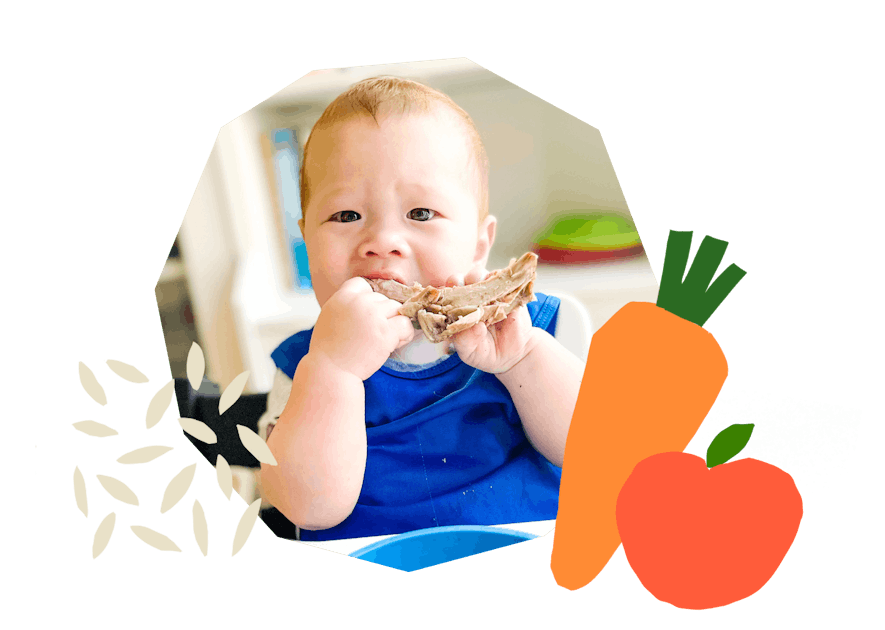
The Program Baby-Led Weaning with Katie Ferraro
A step-by-step digital program for starting solid foods safely and navigating the original 100 FIRST FOODS™ meal plan with baby-led weaning.
 EXPERT-LED, PROVEN APPROACH TO EATING REAL FOOD
EXPERT-LED, PROVEN APPROACH TO EATING REAL FOOD CONCISE VIDEO TRAININGS TO MASTER BABY-LED WEANING
CONCISE VIDEO TRAININGS TO MASTER BABY-LED WEANING 100 FIRST FOODS DAILY MEAL PLAN WITH FOOD PREP VIDEOS
100 FIRST FOODS DAILY MEAL PLAN WITH FOOD PREP VIDEOS
Baby-Led Weaning for Beginners Free Workshop
Is your baby ready to start solid foods, but you’re not sure what to do? Register for this free online video workshop and learn how to give your baby a safe start to solid foods using baby-led weaning. Everyone on this free training receives a copy of Katie’s original 100 FIRST FOODS™ list. You can take this workshop right now, later today when your baby naps, or tomorrow…whatever works for you!
Get baby-led weaning recipes and tips delivered to your email inbox.

